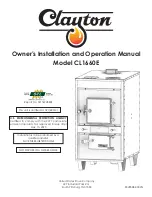
comply with NFPA 90B as tested by UL Standard 181 for Class
1 Rigid air ducts.
5
GAS SUPPLY AND PIPING
5.1
GENERAL
WARNING
FIRE OR EXPLOSION HAZARD
Failure to follow the safety warnings exactly could result
in serious injury, death or property damage. Never test
for gas leaks with an open flame. A fire or explosion
may result causing property damage, personal injury or
loss of life. Use a commercially available soap solution
made specifically for the detection of leaks to check all
connections.
Installations must be made in accordance with all authorities
having jurisdiction.
Use a back-up wrench on the inlet of the gas valve when
connecting the gas line to the gas valve.
Refer to Table 6 for recommended gas pipe sizing. Support
all gas piping with appropriate straps and hangers.
Use a
minimum of 1 hanger every 6 ft (1.8 m). Joint compound (pipe
dope) should be applied sparingly and only to male threads of
joints. Pipe dope must be resistant to the action of propane gas.
An accessible manual shut off valve MUST be installed external
to furnace casing.
Install a sediment trap in riser leading to the furnace as shown
in Figure 15. Connect a capped nipple into lower end of the
tee. The capped nipple should extend below level of furnace
gas controls.
Install a union between the manual shut off gas and the gas
valve in order to remove it easily.
Leak test the unit and gas connections.
The gas supply pressure shall be within the maximum and
minimum inlet supply pressures marked on the rating plate and
in Table 4.
The furnace gas valve inlet pressure tap connection is suitable
to use as a test gauge port providing test pressure.
5.2
PROPANE CONVERSION
To convert from natural to L.P. gas, installer should use the
appropriate conversion kit. Please refer table 26.
Make sure the inlet gas pressure is as indicated in table 4.
The conversion kit consist of orifices, spring and stickers to
clearly identify conversion on the gas valve.
Follow the steps bellow to convert the gas valve to propane :
1. Change the orifice of the manifold, they are provided in
the conversion kit and their size is #56.
2. Remove both regulator cover screws.
3. Remove both regulator adjustment screws (beneath the
cover screws).
4. Remove both Natural Gas regulator springs from
regulator sleeves.
5. Insert the L.P. regulator springs (provided in the
conversion kit) into the regulator sleeves.
6. Place the High regulator adjustment screw and adjust
approximately 4 turns to the bottom stop.
7. Place the Low regulator adjustment screw and adjust
approximately 6 turns to the bottom stop.
8. Start the furnace and adjust both outlet pressures (8.6"
w.c on 2nd stage and 5.0" w.c.
on the first stage).
Clockwise to increase pressure and counter clockwise to
decrease pressure.
9. Place both regulator cover screws.
10. Attach the WARNING label (provided in the kit) to the gas
valve where it can be readily seen. Also attach the small
round L.P. labels to the top of the regulator cover screws.
11. Conversion back to Natural Gas use may be done at
a later date by retaining the Natural Gas springs and
orifice (removed in steps above) and following the same
procedure (except for burner pressures)
5.3
GAS PIPE GROMMET
For direct vent applications, the hole for the gas pipe on the
cabinet must be sealed to prevent air leakage. Make sure the
grommet is in place, then insert the gas pipe.
5.4
SETTING GAS OUTLET
PRESSURE
To ensure the furnace operates to the correct input refer to the
rating plate or to table 5, follow these steps to properly adjust
the outlet gas pressure:
1. Turn off all electrical power to the system.
2. Take the outlet pressure test screw out one turn
counterclockwise. (See outlet pressure boss on figure
13.)
3. Attach a hose and a manometer to the oulet pressure
boss of the valve.
4. Turn on the system power and make a call for first stage
heat on the thermostat.
5. Remove both regulator cover screws and adjust the low
fire regulator (see figures 13 and 14). Adjust the screw
clockwise to increase pressure or counterclockwise to
decrease pressure.
Always adjust the regulator to
provide the correct pressure, as mentionned on the rating
plate and table 5.
6. Make a call for second stage heat on the thermostat.
7. Turn the high fire regulator adjust screw (see figure
13) clockwise to increase pressure or counterclockwise
to decrease pressure.
Always adjust the regulator to
provide the correct pressure, as mentionned on the rating
plate and table 5.
8. Replace regulator cover screws and tighten securely.
9. Turn off all electrical power to the system.
10. Remove the manometer hose from the outlet pressure
boss.
15
Summary of Contents for C105-2-V
Page 24: ...Figure 29 Direct vent clearance 23 ...
Page 25: ...Figure 30 Other than Direct vent clearance 24 ...
Page 32: ...Figure 31 Dimensions 31 ...
Page 33: ...Figure 32 Two Stage ECM Wiring diagram 32 ...
Page 36: ...Figure 33 Exploded view Cxx 2 V part 1 35 ...
















































